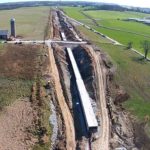- Company: Fay, an i+iconUSA Company
- Industry: Industrial
- Location: Union Bridge, Maryland
- Expected Completion Date: November 6, 2017
- Project Website
The Union Bridge Quarry Replacement project will establish a new limestone quarry in New Windsor, Maryland and transport the limestone to the Union Bridge cement plant via a 4.5 mile conveyor system currently being constructed. This conveyor will travel both underground and on grade. There are six road crossings and four stream crossings. The conveyor will be in a cast in place underground tunnel at all road crossings. There are three of these tunnel sections including 615 linear feet, 6,405 linear feet, and 2,176 linear feet sections. The tunnel excavation depths vary from 16 feet to 60 feet and all tunnel concrete is required to be waterproofed. There is also 12,000 linear feet of conveyor that will be on grade and overhead.
What impact does this project have on America?
This project will provide an estimated 70 years of limestone supply for the Lehigh Cement Company cement plant which is the second largest of its kind in North America. The plant produces approximately three million metric tons of cement each year and supplies the USA and Canada. The project currently employs over sixty individuals. Many options were considered for the transportation of the limestone from the New Windsor quarry to the Union Bridge plant but the conveyor system proved to be the most eco and community friendly. The conveyor has the least environmental impact of all options. To ensure the least community disruption, the conveyor was designed to be underground at all road crossings and in some agricultural areas. The conveyor also has a protective covering in all areas on grade to reduce noise and eliminate dust exposure.
What interesting obstacles or unusual circumstances did you overcome to complete the project?
This project dealt a great deal with the surrounding communities. Activities such as road closings, tunnel excavation, and rock blasting created disturbance to the community which is being managed by keeping close ties with the surrounding neighbors to make sure these disruptions are limited and that all neighbor requests are dealt with in a professional and friendly manner. The tunnel excavations reached 60 foot at their deepest which created the obstacle of dealing with ground water and surface water that found the lowest point in the area. To deal with this, stream water diversions had to be installed and dewatering pumps needed to be utilized around the clock to control the water. To limit disturbance to the community, only one road could be closed at a time so work had to be planned to accommodate this requirement. This took very careful planning scheduling to ensure that road crossings did not delay the progress of the project.
What dangers and risks did you encounter, and describe any extraordinary methods used to keep workers safe?
This project includes deep excavations, rock blasting, and working at heights. Deep excavations were laid back to ensure safe access to the work areas. During rock blasting, warning sirens are being used to warn all workers that a blast is going to occur. A minimum of 1,000 feet of clearance was a established from the site of any blasts to make sure no individuals were in any danger of being struck by fly rock. Blasting mats were also used for larger shots to limit the amount of fly rock that occurred. Messages are also being sent to all community members via text, email, and/or website postings to let them know of the location and time of any planned blasts. While performing work on top of the tunnel, which is greater than six feet high (OSHA requirement for fall protection), life line cables are used to allow individuals to tie-off with fall protection harnesses. In times where this is not feasible, the tunnel is backfilled along the side to within six feet of the top so that the fall hazard is eliminated. All individuals working on site, including subcontractors, are required to have the MSHA Miner training, which is a 24 hour class that goes through all safety hazards while working on a mine site. Fay has also developed a site-specific safety training that all individuals, including subcontractors, must undergo.
How did you leverage new technologies to work faster and reduce waste?
This project utilized GPS for horizontal location and elevation. A base station was set in the middle of the project along with two repeaters towards both ends of the conveyor to broadcast signal to numerous pieces of equipment and handheld receivers. These pieces of equipment and handheld receivers were used for layout as well as excavation and final grading. This system allowed for an easy and efficient means for tracking earthwork and rock blasting quantities. Using this system limited errors in field layout which saved the project both time and money. HCSS HeavyBid was used to bid the project and be successfully awarded it. HeavyBid was also used throughout the project to price change orders and extra work time and material activities. During this project, HCSS HeavyJob was introduced for timecard submission, diary entry, and photo tracking. This provided an easy means for the field to communicate and collaborate with office personnel. Bluebeam Studio is being used for document control. The owner, subcontractors, and Fay are allowed access to the Studio account which allows all individuals to access the same document, ensuring that the most up to date version of each drawing and/or document is being used. Field personnel also had access to the studio project so they can view drawings in the field, eliminating the requirement for paper drawings and eliminating any error due to old revisions.






